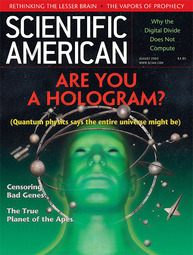
The Holographic Universe - by Michael Talbot
I am reading this book right now and I'm going to post each excerpt I read as I read it to track my progress and I'm going to take notes.
PART I
A REMARKABLE NEW VIEW OF REALITY
Sit down before foct like a little child, and be prepared to give up every preconceived notion, follow humbly wherever and to whatever abyss Nature leads, or you shall learn nothing.
- T. H. Huxley
1 - The Brain as Hologram
It isn’t that the world of appearances is wrong; it isn’t that there aren’t objects out there, at one level of reality. It’s that if you penetrate through and look at the universe with a holographic system, you arrive at a different view, a different reality.
And that other reality can explain things that have hitherto remained inexplicable scientifically: paranormal phenomena, synchronicities, the apparently meaningful coincidence of events.
- Karl Pribram
in an interview in Psychology Today
The puzzle that first started Pribram on the road to formulating his holographic model was the question of how and where memories are stored in the brain.
In the early 1940s, when he first became interested in this mystery, it was generally believed that memories were localized in the brain. Each memory a person had, such as the memory of the last time you saw your grandmother, or the memory of the fragrance of a gardenia you sniffed when you were sixteen, was believed to have a specific location somewhere in the brain cells.
Such memory traces were called engrains, and although no one knew what an engram was made of - whether it was a neuron or perhaps even a special kind of molecule - most scientists were confident it was only a matter of time before one would be found. There were reasons for this confidence. Research conducted by Canadian neurosurgeon Wilder Penfield in the 1920s had offered convincing evidence that specific memories did have specific locations in the brain. One of the most unusual features of the brain is that the object itself doesn’t sense pain directly.
As long as the scalp and skull have been deadened with a local anesthetic, surgery can be performed on the brain of a fully conscious person without causing any pain.
In a series of landmark experiments, Penfield used this fact to his advantage. While operating on the brains of epileptics, he would electrically stimulate various areas of their brain cells. To his amazement he found that when he stimulated the temporal lobes (the region of the brain behind the temples) of one of his fully conscious patients, they re-experienced memories of past episodes from their lives in vivid detail.
One man suddenly relived a conversation he had had with friends in South Africa; a boy heard his mother talking on the telephone and after several touches from Penfield’s electrode was able to repeat her entire conversation; a woman found herself in her kitchen and could hear her son playing outside. Even when Penfield tried to mislead his patients by telling them he was stimulating a different area when he was not, he found that when he touched the same spot it always evoked the same memory.
In his book The Mystery of the Mind, published in 1975, just shortly before his death, he wrote,
“It was evident at once that these were not dreams. They were electrical activations of the sequential record of consciousness, a record that had been laid down during the patient’s earlier experience. The patient ‘re-lived’ all that he had been aware of in that earlier period of time as in a moving-picture ‘flashback.’"
From his research Penfield concluded that everything we have ever experienced is recorded in our brain, from every stranger’s face we have glanced at in a crowd to every spider web we gazed at as a child. He reasoned that this was why memories of so many insignificant events kept cropping up in his sampling. If our memory is a complete record of even the most mundane of our day-to-day experiences, it is reasonable to assume that dipping randomly into such a massive chronicle would produce a good deal of trifling information.
As a young neurosurgery resident, Pribram had no reason to doubt Penfield’s engram theory. But then something happened that was to change his thinking forever. In 1946 he went to work with the great neuropsychologist Karl Lashley at the Yerkes Laboratory of Primate Biology, then in Orange Park, Florida.
For over thirty years Lashley had been involved in his own ongoing search for the elusive mechanisms responsible for memory, and there Pribram was able to witness the fruits of Lashley’s labors firsthand. What was startling was that not only had Lashley failed to produce any evidence of the en-gram, but his research actually seemed to pull the rug out from under all of Penfield’s findings.
What Lashley had done was to train rats to perform a variety of tasks, such as run a maze. Then he surgically removed various portions of their brains and retested them. His aim was literally to cut out the area of the rats’ brains containing the memory of their maze-running ability. To his surprise he found that no matter what portion of their brains he cut out, he could not eradicate their memories.
Often the rats’ motor skills were impaired and they stumbled clumsily through the mazes, but even with massive portions of their brains removed, their memories remained stubbornly intact.
For Pribram these were incredible findings. If memories possessed specific locations in the brain in the same way that books possess specific locations on library shelves, why didn’t Lashley’s surgical plunderings have any effect on them? For Pribram the only answer seemed to be that memories were not localized at specific brain sites, but were somehow spread out or distributed throughout the brain as a whole. The problem was that he knew of no mechanism or process that could account for such a state of affairs.
Lashley was even less certain and later wrote,
"I sometimes feel, in reviewing the evidence on the localization of the memory trace, that the necessary conclusion is that learning just is not possible at all. Nevertheless, in spite of such evidence against it, learning does sometimes occur.” 2
In 1948 Pribram was offered a position at Yale, and before leaving he helped write up thirty years of Lashley’s monumental research.
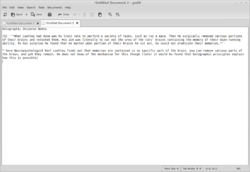
I'll probably be adding some of this stuff to the greenpills thread later.
The Breakthrough
At Yale, Pribram continued to ponder the idea that memories were distributed throughout the brain, and the more he thought about it the more convinced he became.
After all, patients who had had portions of their brains removed for medical reasons never suffered the loss of specific memories. Removal of a large section of the brain might cause a patient’s memory to become generally hazy, but no one ever came out of surgery with any selective memory loss.
Similarly, individuals who had received head injuries in car collisions and other accidents never forgot half of their family, or half of a novel they had read. Even removal of sections of the temporal lobes, the area of the brain that had figured so prominently in Penfield’s research, didn’t create any gaps in a person’s memories.
Pribram’s thinking was further solidified by his and other researchers’ inability to duplicate Penfield’s findings when stimulating brains other than those of epileptics. Even Penfield himself was unable to duplicate his results in non-epileptic patients.
Despite the growing evidence that memories were distributed, Pribram was still at a loss as to how the brain might accomplish such a seemingly magical feat. Then in the mid-1960s an article he read in Scientific American describing the first construction of a hologram hit him like a thunderbolt. Not only was the concept of holography dazzling, but it provided a solution to the puzzle with which he had been wrestling.
To understand why Pribram was so excited, it is necessary to understand a little more about holograms. One of the things that makes holography possible is a phenomenon known as interference. Interference is the crisscrossing pattern that occurs when two or more waves, such as waves of water, ripple through each other. For example, if you drop a pebble into a pond, it will produce a series of concentric waves that expands outward. If you drop two pebbles into a pond, you will get two sets of waves that expand and pass through one another. The complex arrangement of crests and troughs that results from such collisions is known as an interference pattern.
Any wavelike phenomena can create an interference pattern, including light and radio waves. Because laser light is an extremely pure, coherent form of light, it is especially good at creating interference patterns. It provides, in essence, the perfect pebble and the perfect pond. As a result, it wasn’t until the invention of the laser that holograms, as we know them today, became possible.
A hologram is produced when a single laser light is split into two separate beams. The first beam is bounced off the object to be photographed. Then the second beam is allowed to collide with the reflected tight of the first. When this happens they create an interference pattern which is then recorded on a piece of film (see fig, 1).
To the naked eye the image on the film looks nothing at all like the object photographed. In fact, it even looks a little like the concentric rings that form when a handful of pebbles is tossed into a pond (see fig. 2). But as soon as another laser beam (or in some instances just a bright light source) is shined through the film, a three-dimensional image of the original object reappears. The three-dimensionality of such images is often eerily convincing. You can actually walk around a holographic projection and view it from different angles as you would a real object.
However, if you reach out and try to touch it, your hand will waft right through it and you will discover there is really nothing there (see fig. 3).

FIGURE 1.
A hologram is produced when a single laser light is split into two separate beaniE.
The first beam is bounced off the object to be photographed, in this case an apple.
Then the second beam is allowed to collide with the reflected light of the first, and the resulting interference pattern is recorded on film.
Three-dimensionality is not the only remarkable aspect of holograms. If a piece of holographic film containing the image of an apple is cut in half and then illuminated by a laser, each half will still be found to contain the entire image of the apple!
Even if the halves are divided again and then again, an entire apple can still be reconstructed from each small portion of the film (although the images will get hazier as the portions get smaller).
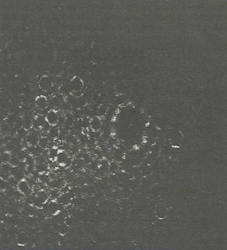
FIGURE 2.
A piece of holographic film containing an encoded image.
To the naked eye the image on the film looks nothing like the object photographed
and is composed of irregular ripples known as interference patterns.
However, when the film is illuminated with another laser,
a three-dimensional image of the original object reappears.
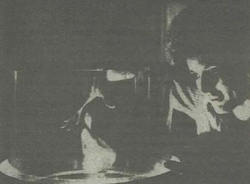
FIGURE 3.
The three-dimensionality of a hologram is often so eerily convincing
that you can actually walk around it and view it from different angles.
But if you reach out and try to touch it, your hand will waft right through it
[”Celeste Undressed.” Holographic stereogram by Peter Claudius, 1978.
Photograph by Brad Cantos, collection of The Museum of Holography]
Unlike normal photographs, every small fragment of a piece of holographic film contains all the information recorded in the whole (see fig. 4).*
This was precisely the feature that got Pribram so excited, for it offered at last a way of understanding how memories could be distributed rather than localized in the brain. If it was possible for every portion of a piece of holographic film to contain all the information necessary to create a whole image, then it seemed equally possible for every part of the brain to contain all of the information necessary to recall a whole memory.
* It should be noted that this astounding trait is common only to pieces of holographic film whose images are invisible to the naked eye. If you buy a piece of holographic film (or an object containing a piece of holographic film) in a store and can see a three-dimensional image in it without any special kind of illumination, do not cut it in half. You will only end UP with pieces of the original image.
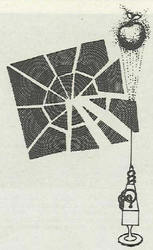
FIGURE 4.
Unlike normal photographs, every portion of a piece of holographic film contains all of the information of the whole.
Thus if a holographic plate is broken into fragments, each piece can still be used to reconstruct the entire image.
Vision Also Is Holographic
Memory is not the only thing the brain may process holographically.
Another of Lashley’s discoveries was that the visual centers of the brain were also surprisingly resistant to surgical excision. Even after removing as much as 90 percent of a rat’s visual cortex (the part of the brain that receives and interprets what the eye sees), he found it could still perform tasks requiring complex visual skills.
Similarly, research conducted by Pribram revealed that as much as 98 percent (the part of the brain that receives and interprets what the eye sees), he found it could still perform tasks requiring complex visual skills. Similarly, research conducted by Pribram revealed that as much as 98 percent of a cat’s optic nerves can be severed without seriously impairing its ability to perform complex visual tasks.3
Such a situation was tantamount to believing that a movie audience could still enjoy a motion picture even after 90 percent of the movie screen was missing, and his experiments presented once again a serious challenge to the standard understanding of how vision works. According to the leading theory of the day, there was a one-to-one correspondence between the image the eye sees and the way that image is represented in the brain. In other words, when we look at a square, it was believed the electrical activity in our visual cortex also possesses the form of a square (see fig. 5).
Although findings such as Lashley’s seemed to deal a deathblow to this idea, Pribram was not satisfied. While he was at Yale he devised a series of experiments to resolve the matter and spent the next seven years carefully measuring the electrical activity in the brains of monkeys while they performed various visual tasks. He discovered that not only did no such one-to-one correspondence exist, but there wasn’t even a discernible pattern to the sequence in which the electrodes fired.
He wrote of his findings,
“These experimental results are incompatible with a view that a photographic-like image becomes projected onto the cortical surface.”
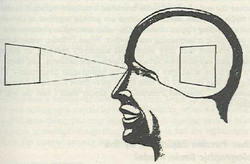
FIGURE 5.
Vision theorists once believed there was a one-to-one correspondence
between an image the eye sees and how that image is represented in the brain.
Pribram discovered this is not true.
Once again the resistance the visual cortex displayed toward surgical excision suggested that, like memory, vision was also distributed, and after Pribram became aware of holography he began to wonder if it, too, was holographic.
The “whole in every part” nature of a hologram certainly seemed to explain how so much of the visual cortex could be removed without affecting the ability to perform visual tasks. If the brain was processing images by employing some kind of internal hologram, even a very small piece of the hologram could still reconstruct the whole of what the eyes were seeing. It also explained the lack of any one-to-one correspondence between the external world and the brain’s electrical activity.
Again, if the brain was using holographic principles to process visual information, there would be no more one-to-one correspondence between electrical activity and images seen than there was between the meaningless swirl of interference patterns on a piece of holographic film and the image the film encoded.
The only question that remained was what wavelike phenomenon the brain might be using to create such internal holograms. As soon as Pribram considered the question he thought of a possible answer. It was known that the electrical communications that take place between the brain’s nerve cells, or neurons, do not occur alone.
Neurons possess branches like little trees, and when an electrical message reaches the end of one of these branches it radiates outward as does the ripple in a pond. Because neurons are packed together so densely, these expanding ripples of electricity - also a wavelike phenomenon - are constantly crisscrossing one another.
When Pribram remembered this he realized that they were most assuredly creating an almost endless and kaleidoscopic array of interference patterns, and these in turn might be what give the brain its holographic properties.
“The hologram was there all the time in the wave-front nature of brain-cell connectivity,” observed Pribram. “We simply hadn’t had the wit to realize it,”
Other Puzzles Explained by the Holographic Brain Model
Pribram published his first article on the possible holographic nature of the brain in 1966, and continued to expand and refine his ideas during the next several years.
As he did, and as other researchers became aware of his theory, it was quickly realized that the distributed nature of memory and vision is not the only neurophysiologies! puzzle the holographic model can explain.
THE VASTNESS OF OUR MEMORY
Holography also explains how our brains can store so many memories in so little space.
The brilliant Hungarian-born physicist and mathematician John von Neumann once calculated that over the course of the average human lifetime, the brain stores something on the order of 2.8 X 1020 (280,000,000,000,000,000,000) bits of information. This is a staggering amount of information, and brain researchers have long struggled to come up with a mechanism that explains such a vast capability.
Interestingly, holograms also possess a fantastic capacity for information storage. By changing the angle at which the two lasers strike a piece of photographic film, it is possible to record many different images on the same surface. Any image thus recorded can be retrieved simply by illuminating the film with a laser beam possessing the same angle as the original two beams.
By employing this method researchers have calculated that a one-inch-square of film can store the same amount of information contained in fifty Bibles! 6
OUR ABILITY TO BOTH RECALL AND FORGET
Pieces of holographic film containing multiple images, such as those described above, also provide a way of understanding our ability to both recall and forget.
When such a piece of film is held in a laser beam and tilted back and forth, the various images it contains appear and disappear in a glittering stream. It has been suggested that our ability to remember is analogous to shining a laser beam on such a piece of film and calling up a particular image.
Similarly, when we are unable to recall something, this may be equivalent to shining various beams on a piece of multiple-image film, but failing to find the right angle to call up the image/memory for which we are searching.
ASSOCIATIVE MEMORY
In Proust’s Swann‘s Way a sip of tea and a bite of a small scallop-shaped cake known as a petite madeleine cause the narrator to find himself suddenly flooded with memories from his past.
At first he is puzzled, but then, slowly, after much effort on his part, he remembers that his aunt used to give him tea and madeleines when he was a little boy, and it is this association that has stirred his memory.
We have all had similar experiences - a whiff of a particular food being prepared, or a glimpse of some long-forgotten object - that suddenly evoke some scene out of our past.
The holographic idea offers a further analogy for the associative tendencies of memory.
This is illustrated by yet another kind of holographic recording technique.
First, the light of a single laser beam is bounced off two objects simultaneously, say an easy chair and a smoking pipe. The light bounced off each object is then allowed to collide, and the resulting interference pattern is captured on film.
Then, whenever the easy chair is illuminated with laser light and the light that reflects off the easy chair is passed through the film, a three-dimensional image of the pipe will appear. Conversely, whenever the same is done with the pipe, a hologram of the easy chair appears.
So, if our brains function holographically, a similar process may be responsible for the way certain objects evoke specific memories from our past.